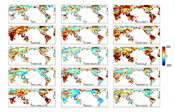Rising global temperatures and changing precipitation patterns can produce heat waves, floods and droughts. To understand these hazards better, researchers are beginning to examine the relationship between temperature and precipitation extremes. The results of such a study have been published in Environmental Research Letters (ERL).
Previous studies have established that the climate is warming around the globe and that there is an increase in extreme weather events, but few studies have considered concurrent temperature and precipitation extremes. The new research is the first to examine four combinations of abnormal climate conditions – warm or cold and wet or dry – in the recently released Coupled Model Intercomparison Project Phase 5 (CMIP5) climate simulations. Warm and dry extremes are of particular concern because they often result in heat waves and droughts, which threaten human life, the environment and economic infrastructures.
Scientists from the University of California Irvine and the Lawrence Livermore National Laboratory, both in the US, used climate model simulations and ground-based observations to study joint occurrences of extreme temperature and precipitation. They found substantial increases in warm/dry and warm/wet conditions in both the observations and simulations of the recent historical climate.
To investigate paired climate extremes, the researchers tallied instances of joint extremes of monthly temperature and precipitation during the period 1951–2004 in gridded observations supplied by the University of Delaware and the UK’s Climatic Research Unit. The team then evaluated 13 CMIP5 model simulations of historical climate for the same time period relative to these observations, with all comparisons being made on a common global grid.
The simulations and the observations both showed an increase in warm/wet and warm/dry conditions during 1978–2004 relative to 1951–1977. Warm/wet conditions increased primarily over high latitudes, and warm/dry conditions also increased in many other regions, particularly in central Africa, eastern Australia, parts of Russia, northern China and the Middle East. In contrast, cold/wet and cold/dry conditions have decreased in most parts of the world.
The results reveal that the CMIP5 climate model simulations are in reasonable agreement with ground-based observations. However, the simulations also show notable discrepancies in that the modelled regional magnitudes and patterns of extremes do not generally agree well with observations.
The study is published in Environmental Research Letters.








No comments:
Post a Comment